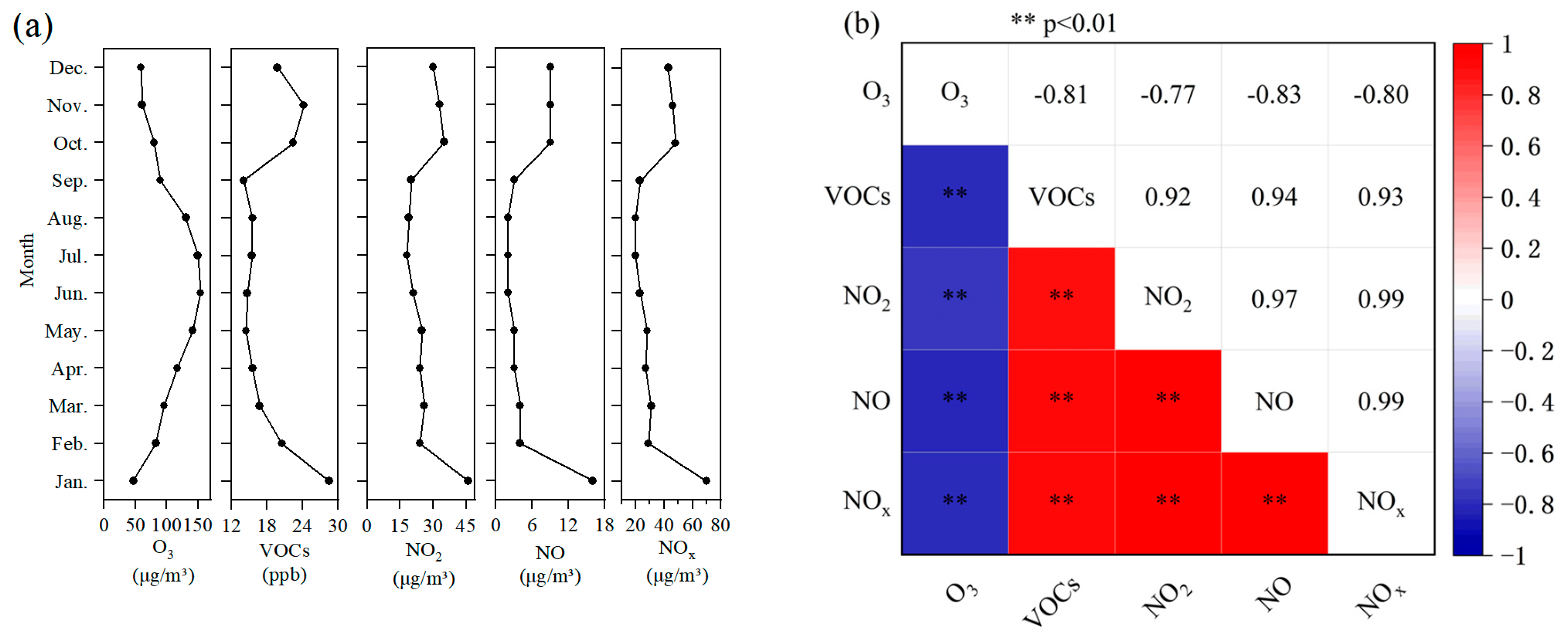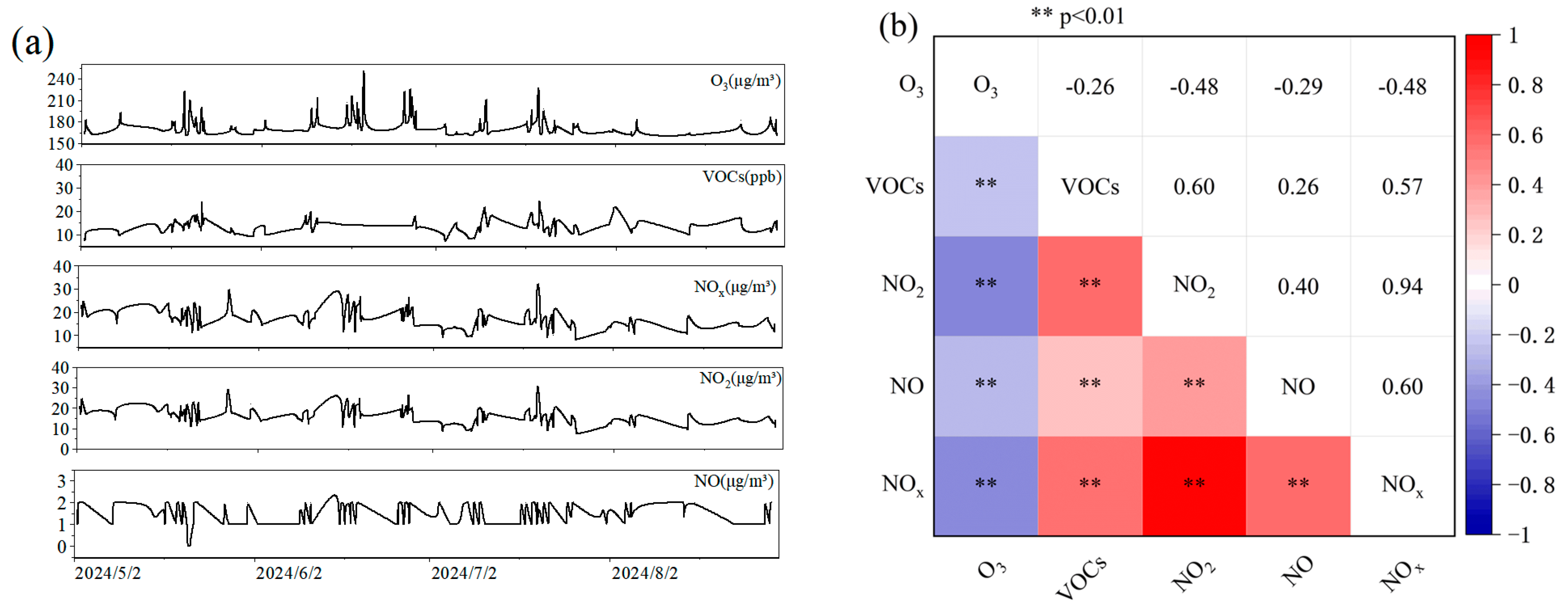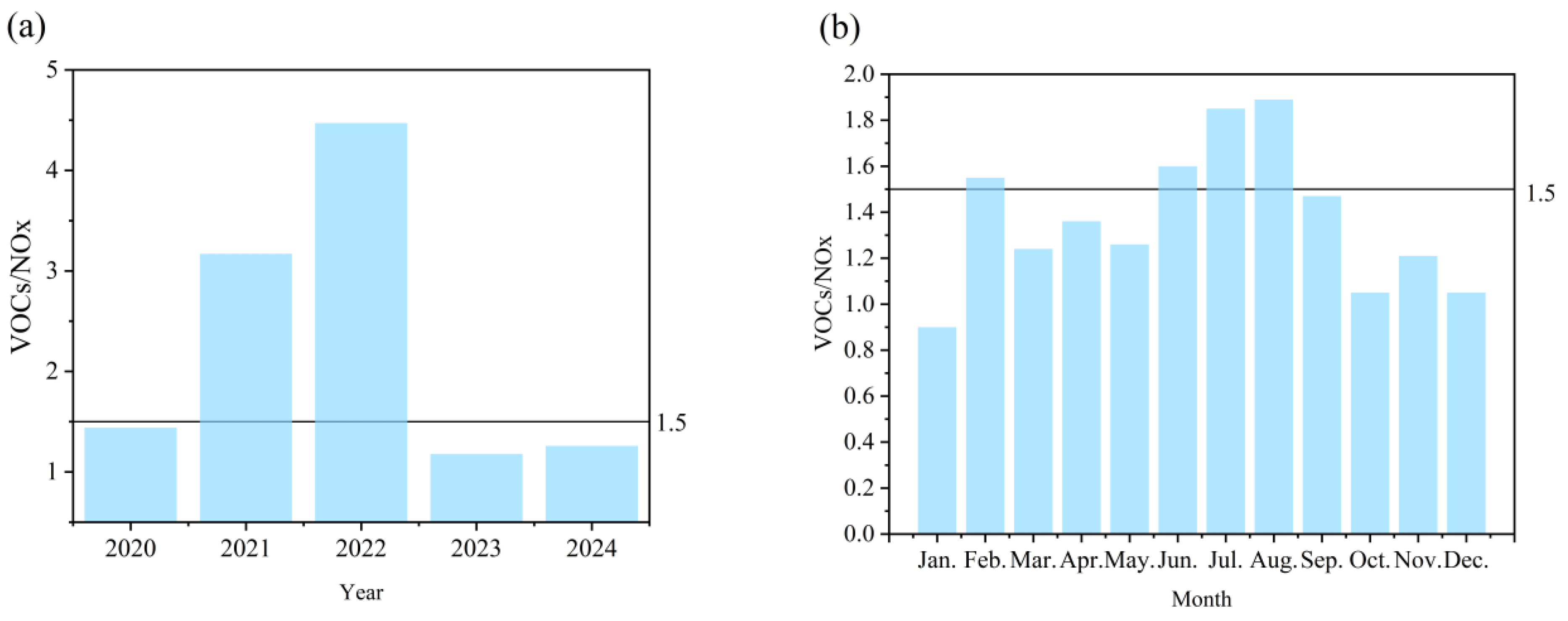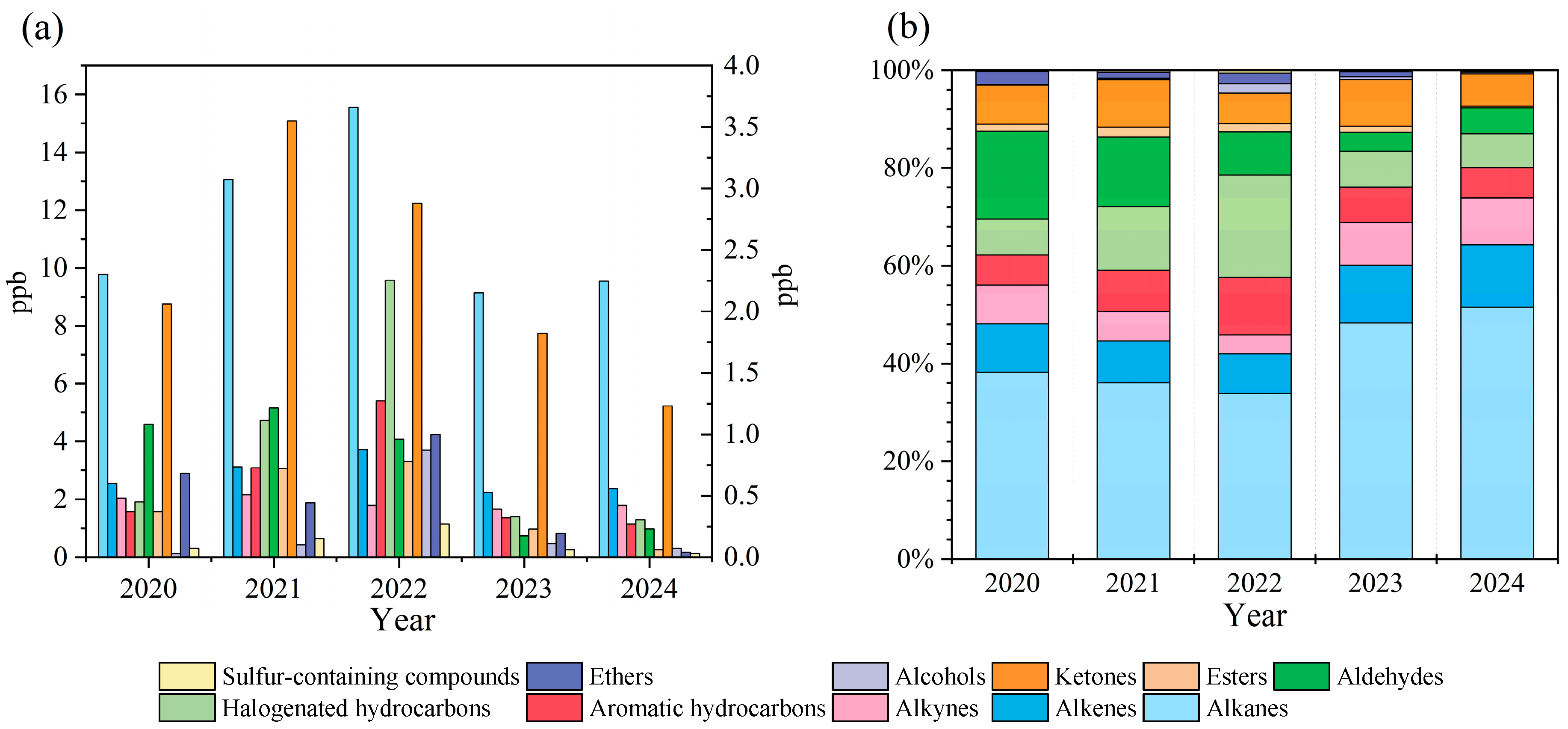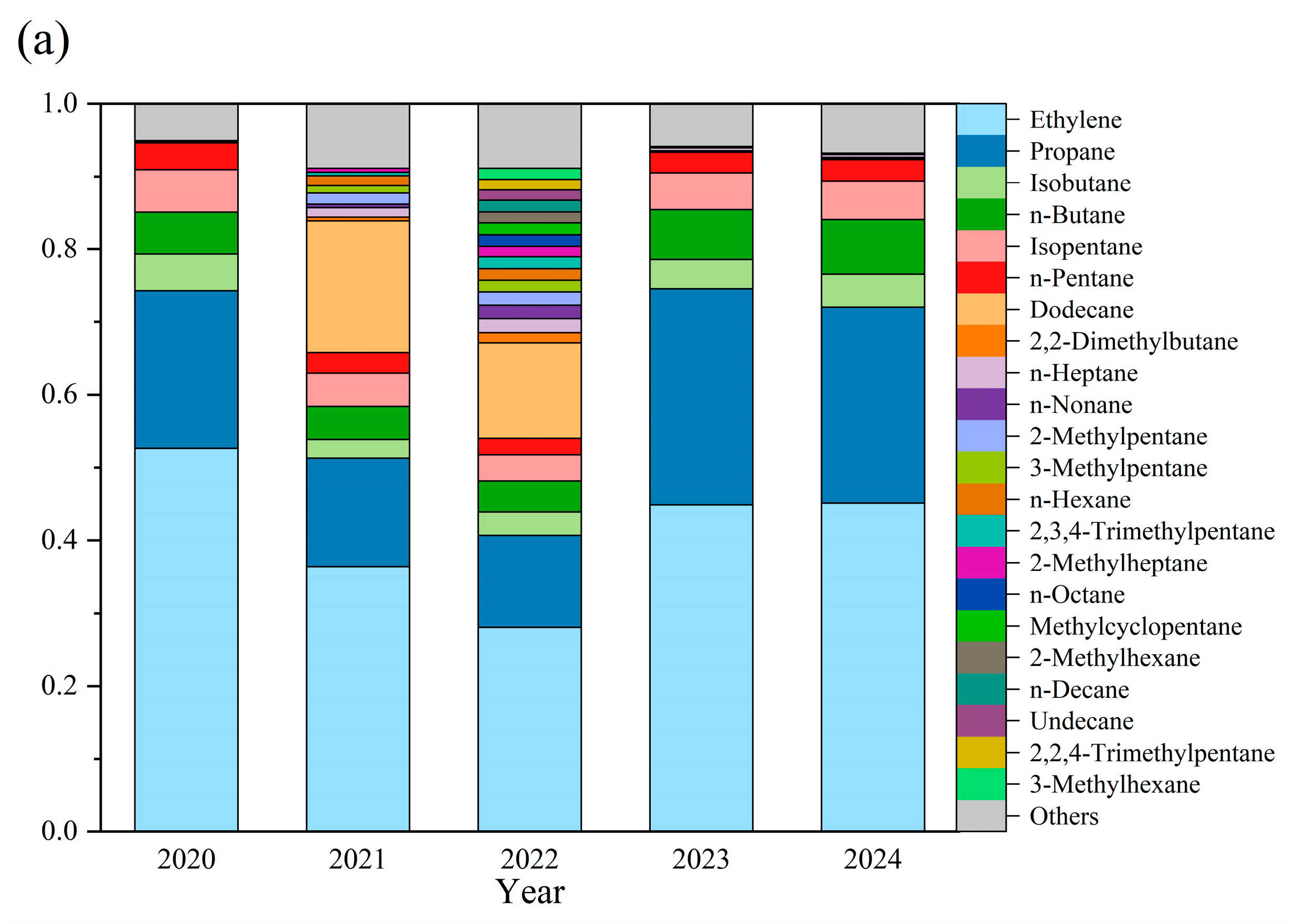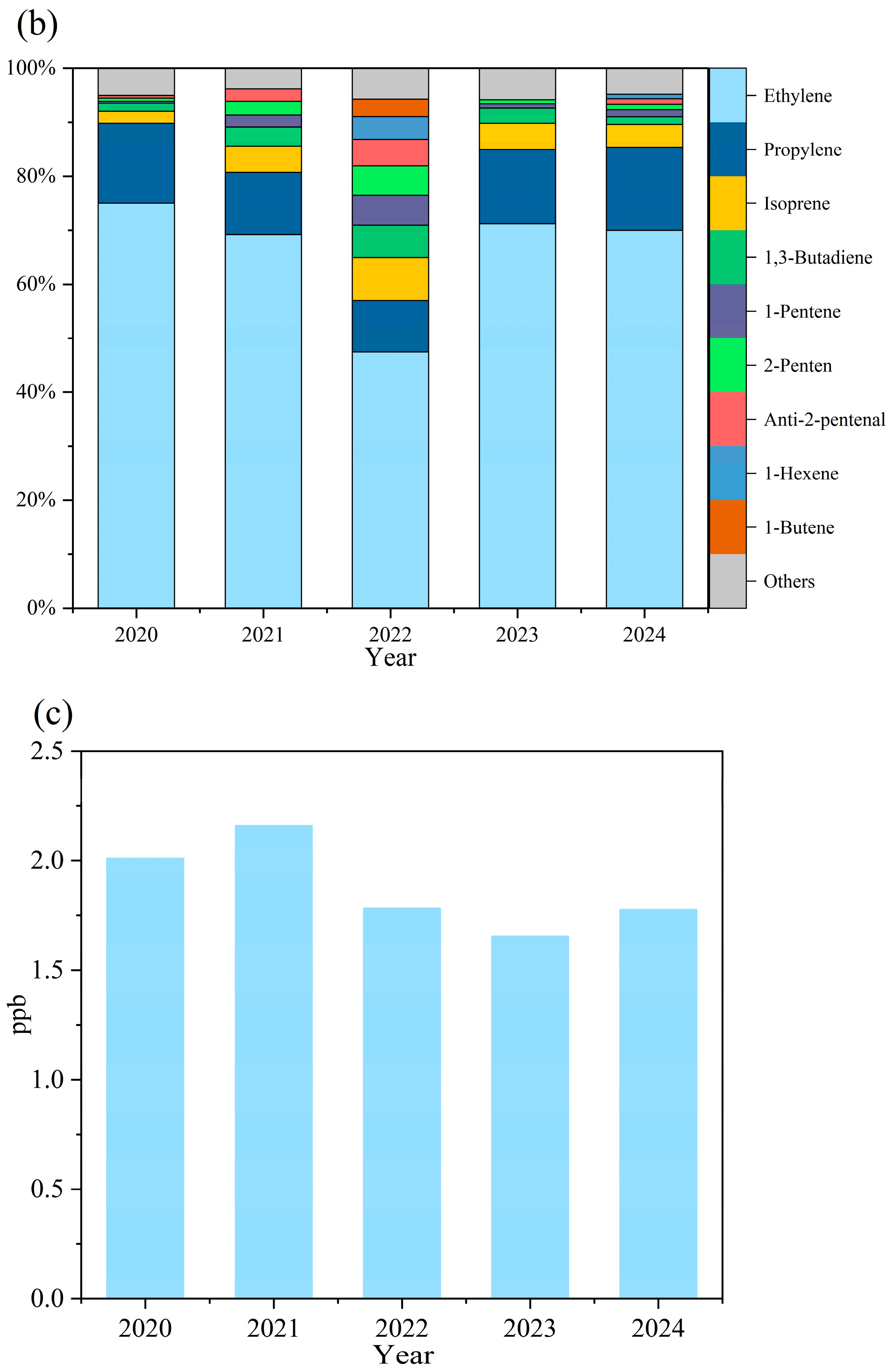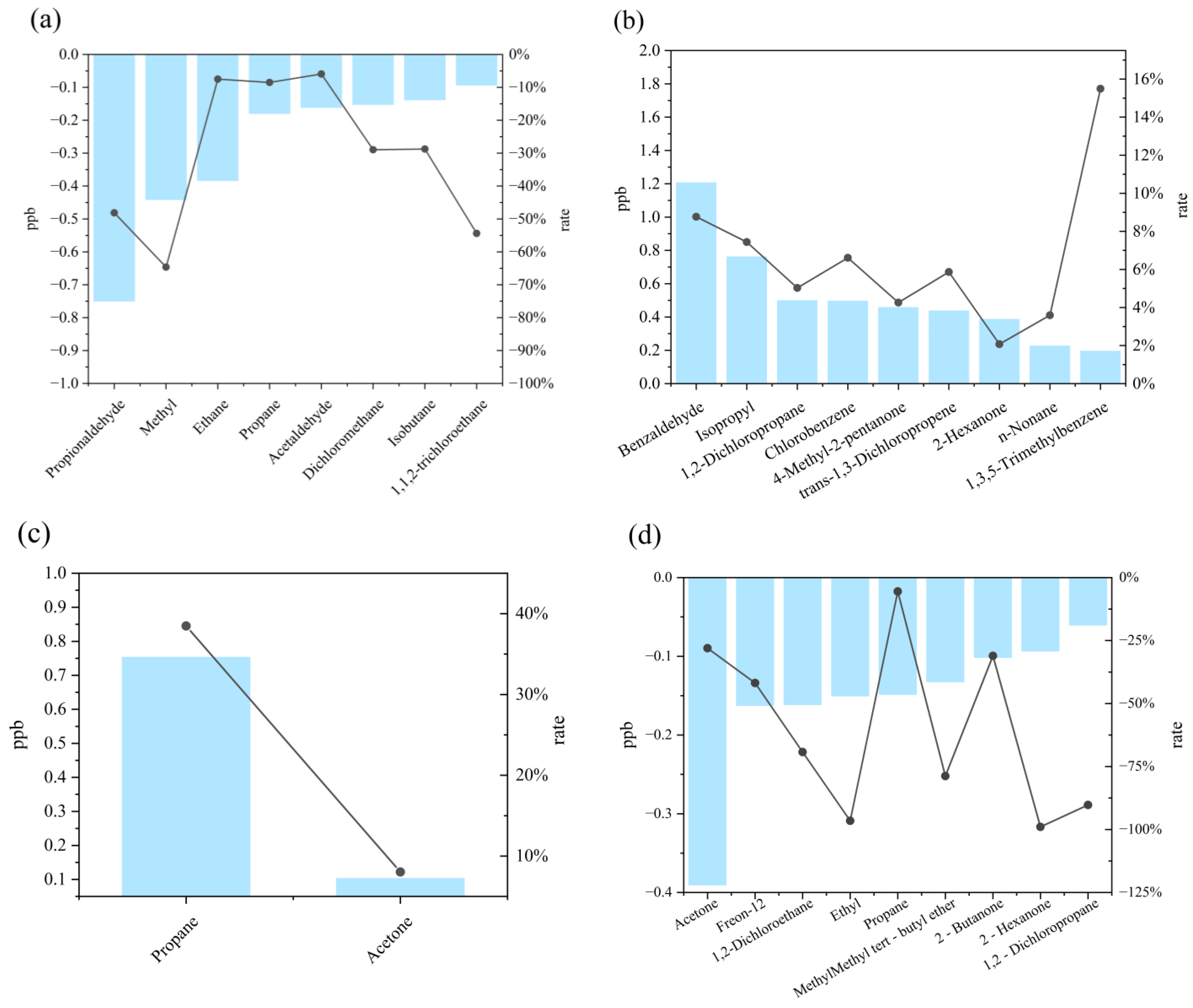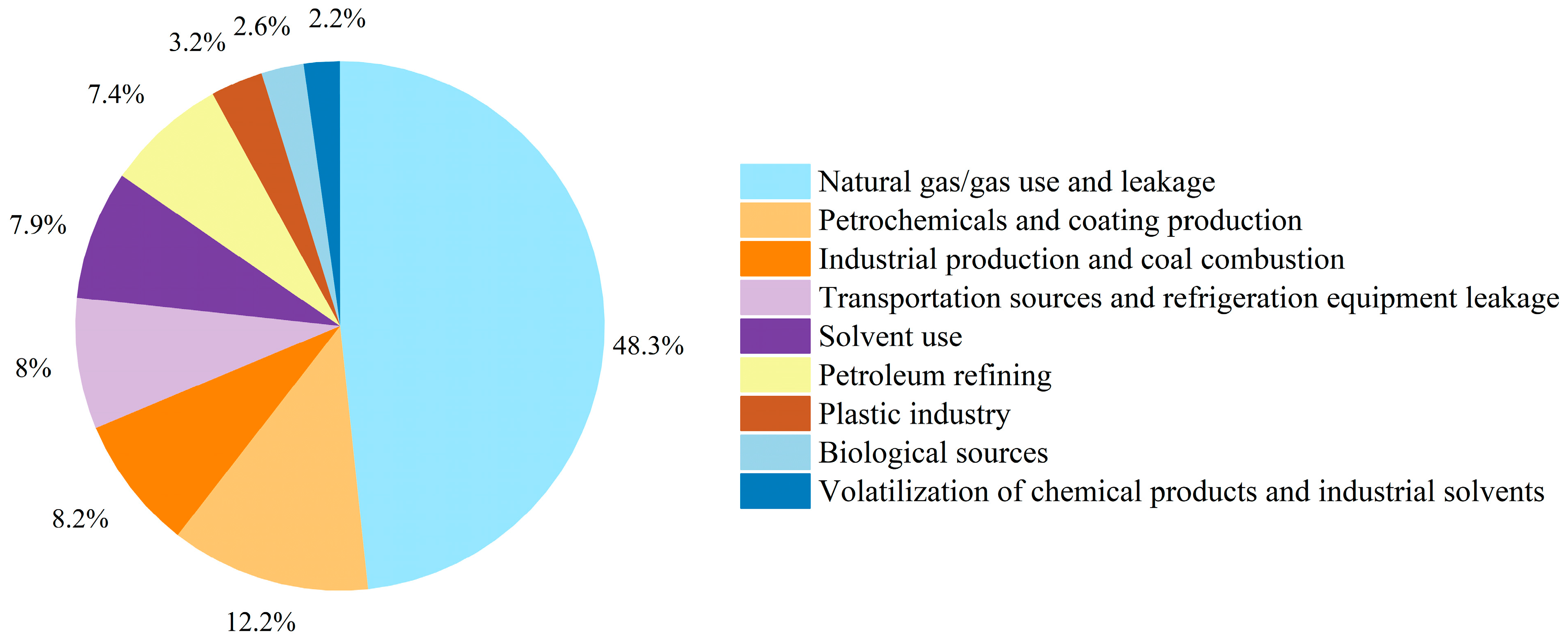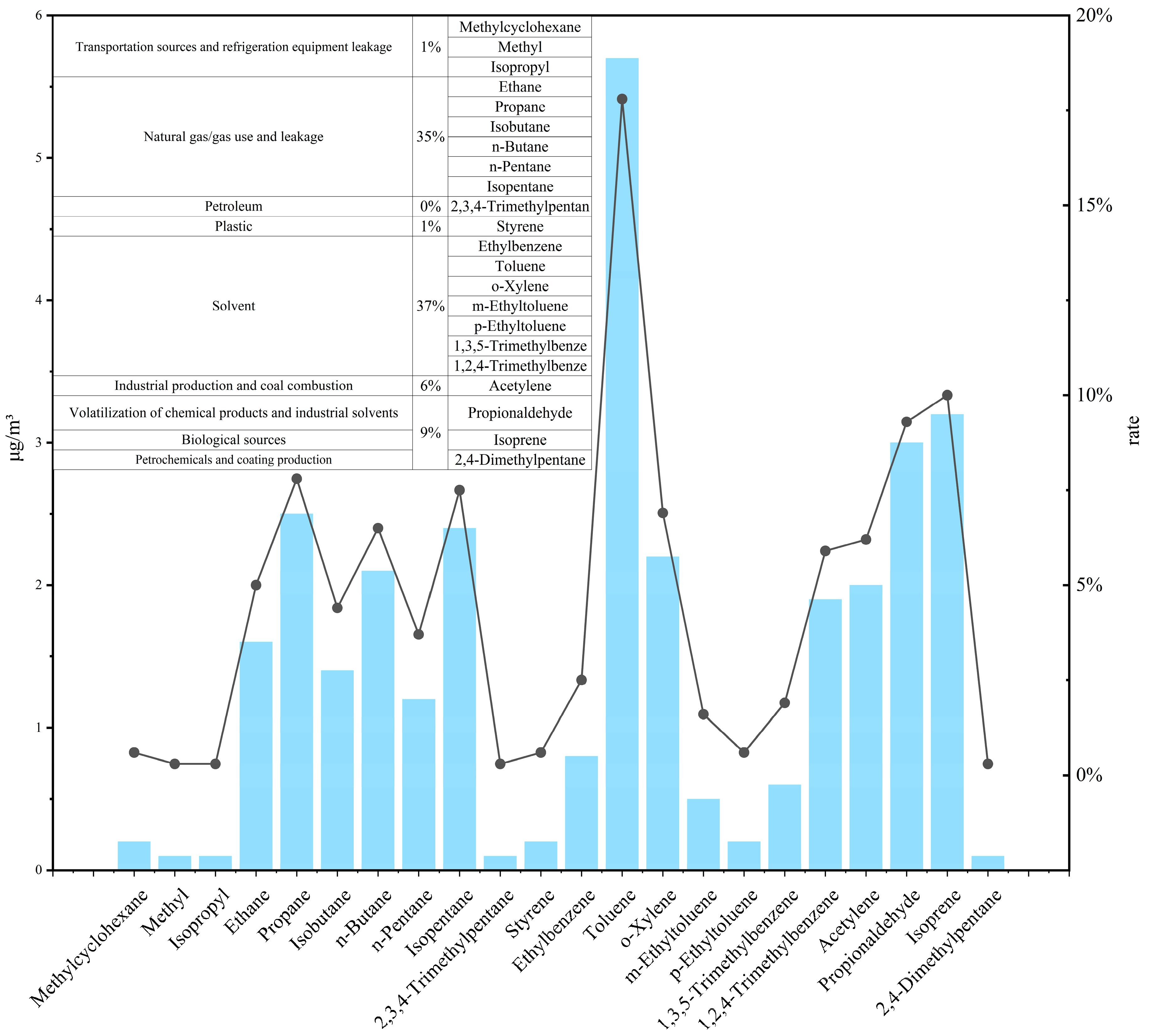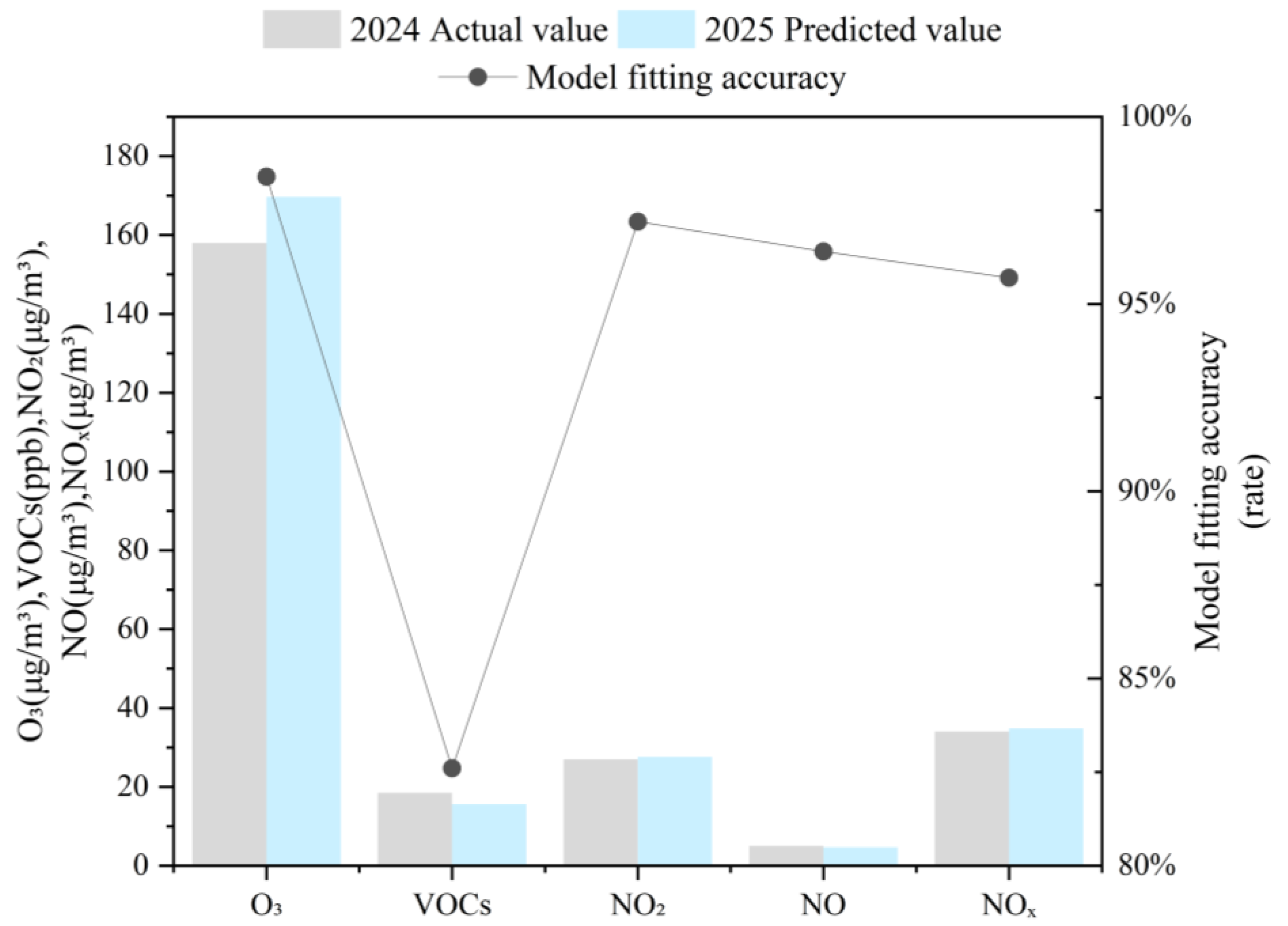3.1. Temporal Evolution and Correlation Dynamics of Multi-Pollutant Concentrations
Based on continuous monitoring data for ozone and its precursors (O3, volatile organic compounds, NO2, NO, and NOx) from 2020 to 2024, this study comprehensively reveals their evolving patterns and intrinsic interrelationships.
Figure 1a reveals a fluctuating upward trend in the annual mean O
3 concentration (+7.5%), peaking at 160 μg m
−3 in 2023. This indicates persistent intensification of photochemical pollution pressure. Volatile organic compounds (VOCs) displayed a distinct “rapid increase followed by a steep decline”: concentrations surged by 79.3% during 2020–2022, then decreased sharply to 18.3 ppb in 2023–2024 (representing a 60.1% reduction from peak levels). This pattern suggests significant enhancement of VOC emission control measures post-2022. Concurrently, nitrogen oxide components exhibited sustained declines: NO
2 decreased by 12.9%, NO underwent a pronounced reduction of 44.4%, and NO
x decreased synchronously by 20.9%.
Pearson correlation analysis revealed a significant coupling relationship between air pollutants in Datong City (
Figure 1b). The NO
x component is highly homogeneous, showing extremely strong positive correlations with NO (r = 0.89,
p < 0.05) and NO
2 (r = 0.97,
p < 0.01), confirming the synergistic release characteristics of traffic sources and industrial combustion emissions. O
3 showed significant negative correlations with NO, NO
2, and NO
x (r = −0.59 to −0.29,
p < 0.05), confirming that the NO titration effect is the core pathway for ozone reduction in Datong City. VOCs showed no significant statistical association with other pollutants, reflecting the separation of their sources (such as solvent evaporation and chemical processes) from the NO
x emission system.
Figure 2a. Monthly monitoring data for ozone (O
3) and its precursors throughout 2024 reveal distinct seasonal variations in pollutant concentrations. Ozone (O
3) exhibited a distinct unimodal pattern, reaching its minimum concentration in January (47 μg m
−3) and peaking in June (154 μg m
−3), demonstrating a strong correlation with solar radiation intensity [
16]. The mean summer (June–August) concentration (145 μg m
−3) was significantly higher than the winter (December–February) mean (63 μg m
−3). Volatile organic compounds (VOCs) displayed a “high winter, low summer” pattern. Winter concentrations (e.g., 28.5 ppb in January) were 2.02 times higher than summer concentrations (e.g., 14.1 ppb in September). A secondary peak occurred in October (22.4 ppb), likely associated with enhanced biogenic emissions during autumn and a reduction in the atmospheric boundary layer height. The concentrations of nitrogen oxides (NO
x) were 3.5 times higher in winter than in summer. Nitrogen monoxide (NO) showed the greatest monthly variability, decreasing from 16 μg m
−3 in January to 2 μg m
−3 in June. This pattern reflects increased cold-start emissions from vehicles during winter and reduced photolysis rates. Nitrogen dioxide (NO
2) concentrations closely tracked the heating season, with levels in January (46 μg m
−3) significantly exceeding those in July (18 μg m
−3).
Figure 2b. Pearson correlation analysis at the monthly scale revealed statistically significant coupling features (
p < 0.01). Strong correlations were observed among ozone and its precursors. Specifically, NO
x exhibited near-perfect correlation with NO (r = 0.99) and NO
2 (r = 0.99), while the correlation between NO and NO
2 was also exceptionally high (r = 0.97). This reflects tight coupling in the emission and transformation processes of nitrogen oxides. Ozone (O
3) demonstrated strong negative correlations with NO (r = −0.83), NO
2 (r = −0.77), and NO
x (r = −0.80). This confirms that the chemical titration mechanism (O
3 + NO → NO
2), where NO consumes O
3, is the dominant pathway controlling ozone concentrations in this region. VOCs showed strong positive correlations approaching collinearity with nitrogen oxide components. This analysis identifies, for the first time, motor vehicle exhaust as the predominant source of VOC-NO
x co-emissions in Datong City.
Based on summer (May–September 2024) hourly monitoring data (
Figure 3a), we analyzed the co-variation patterns of pollutants during high-concentration ozone (O
3) events (O
3 ≥ 160 μg m
−3). O
3 exceedance events exhibited a pronounced diurnal pattern, with 82% concentrated between 12:00 and 18:00 local time, peaking at 253 μg m
−3 (14:00 on 20 June 2024). This pattern primarily arises from intense solar radiation driving photochemical reactions (NO
x + VOCs → O
3), coupled with afternoon boundary layer elevation facilitating the dilution of precursors accumulated earlier. The 2024 high-O
3 events showed strong coupling with meteorological conditions characterized by high daily mean temperature (>28 °C) and low relative humidity (<60%). A representative case occurred on June 20th (12:00–16:00), where O
3 concentrations persistently exceeded 228 μg m
−3 under conditions of 35 °C air temperature and 45% relative humidity. Distinct precursor patterns emerged during O
3 ≥ 160 μg m
−3: NO
x concentrations fell within a low-to-moderate range (8–36 μg m
−3), significantly below the summer mean (22.6 μg m
−3) and overall range (5–190 μg m
−3). NO concentrations were extremely low (0–3 μg m
−3), well below both its mean (2.3 μg m
−3) and range (0–63 μg m
−3). The NO
2/NO
x ratio increased to about 95% (compared to about 93% during low-O
3 periods). This signature indicates active photochemical processes consuming NO and promoting the conversion of NO
2 to O
3. Concurrently, 87.8% of high-O
3 events coincided with VOCs > 10 ppb. However, the overall linear correlation between O
3 and VOCs was weak (r = −0.26;
Figure 3b). Analysis of specific high-O
3 periods (e.g., 12:00–15:00 on 11 July 2024) revealed that O
3 concentrations remained elevated (206–210 μg m
−3) when VOCs exceeded 17 ppb. This observation suggests that O
3 formation in this region may occur within a VOC-limited regime. In summary, the synergistic effects of summer afternoon meteorological conditions (high temperature, low humidity) and specific precursor concentration ranges (low NO
x, very low NO, and relatively higher VOCs) constitute the primary drivers of O
3 exceedances in Datong City.
Figure 3b. Pearson correlation analysis on summer hourly data reveals key features of O
3 pollution formation. Statistically significant correlations (
p < 0.01) were observed among all five pollutants. NO
x exhibited a strong positive correlation with NO (r = 0.60) and an exceptionally strong positive correlation with NO
2 (r = 0.94). The correlation between NO and NO
2 was modest but significant (r = 0.40). O
3 demonstrated significant negative correlations with NO (r = −0.29), NO
2 (r = −0.48), and NO
x (r = −0.48). VOCs showed positive correlations with nitrogen oxide components (r = 0.26 to 0.60) and a marginally negative correlation with O
3 (r = −0.26). This analysis highlights the complex interactions governing summer O
3 precursors. Hierarchical Structure within NO
x Emissions: The exceptionally strong co-variability between NO
2 and NO
x (r = 0.94) reflects their common emission sources (e.g., motor vehicle exhaust, industrial combustion). In contrast, the weaker correlation between NO and NO
2 (r = 0.40) suggests rapid atmospheric consumption of NO. Dominance of NO Titration: The significant negative correlations between O
3 and all NO
x components confirm the NO titration mechanism (O
3 + NO → NO
2) as the primary O
3 sink. The stronger negative correlation with NO
2 (r = −0.48) compared to NO (r = −0.29) likely indicates the accumulation of NO
2 as a reaction product under intense photochemistry. VOC Source–Sink Paradox: The moderate positive correlations between VOCs and NO
x components (r = 0.26–0.60) point towards shared emission sources, predominantly motor vehicle exhaust fumes. However, the weak negative correlation between VOCs and O
3 (r = −0.26) contrasts with conventional photochemical theory and reveals a source–sink paradox for VOCs in this system.
The VOC/NO
x ratio serves as the key indicator for defining ozone (O
3) formation sensitivity regimes (VOC-limited, NO
x-limited, or transitional), providing critical guidance for formulating differentiated pollution control strategies [
17]. Annual mean VOC/NO
x ratios in Datong City during 2020–2024 exhibited marked interannual variations (
Figure 4a), clearly delineating an evolutionary trajectory from a “co-driven” regime towards “NO
x-limited” sensitivity for ozone formation. The anomalously high ratio in 2022 (4.47) stemmed from the confluence of weak industrial NO
x controls and a substantial concurrent surge in VOC emissions (+79.3%;
Figure 1a), resulting in an ozone pollution pattern co-driven by VOCs and NO
x. This conclusion is corroborated by two independent lines of evidence: (i) a significantly weakened O
3-NO
x negative correlation (r = −0.41;
Figure 3b) indicative of radical termination reactions approaching saturation; and (ii) the implementation of enhanced VOC control measures post-2022, which led to a 60.1% reduction in VOC concentration from its peak value (
Figure 1a). The persistently low ratios observed in 2023–2024 (≤1.5) signify a transition to a NO
x-limited ozone formation regime during non-summer months. This shift is robustly supported by O
3-DEP (ozone formation potential) box model simulations (R
2 = 0.93). The direct environmental benefit of this sensitivity transition is evidenced by a significant 9.2% year-on-year decrease in regional O
3 concentrations during the summer periods of 2023–2024 under comparable meteorological conditions, confirming the efficacy of the prior intensive VOC abatement strategy. The anomalous ratio observed in 2021 (3.17) was primarily attributable to stagnant weather conditions (characterized by a 28% reduction in the mixing layer height compared to 2020), which exacerbated localized VOC accumulation. Positive Matrix Factorization (PMF) source apportionment further identified industrial activities—particularly petroleum refining and paint manufacturing (contributing 33.7%)—as a major source of VOCs during this period.
The monthly data for Datong City in 2024 (
Figure 4b) show a significant seasonal photochemical pattern, accurately depicting the spatiotemporal evolution of ozone formation mechanisms. During the winter (December to February), NO
x limitations dominate (ratio 0.90–1.05). At this time, heating demand and stable weather conditions in the region lead to increased NO
x emissions, while biogenic VOCs are suppressed. Model simulations confirm that ozone formation during this period shows a weak response to VOC reductions, consistent with NO
x-constrained characteristics. The extremely low ratio (0.90) in January highlights the impact of coal-fired heating emissions (high NO
x, low VOCs). The O
3-DEP box model validates that under these conditions, the NO titration effect (O
3 + NO → NO
2) dominates, leading to suppressed winter ozone levels and ineffective VOC control. Summer (June–August) represents the peak VOC-constrained period (ratio 1.60–1.89), with strong biogenic VOC emissions and active photochemical reactions accelerating NO
x consumption. The peak ratio in July–August (1.85–1.89) marks the highest severity of VOC constraints. Sensitivity analysis shows that the VOC reduction efficiency during this phase is 3.2 times that of NO
x control (O
3 reduction per unit emission). During the transition periods (March–May and September–November), the ratio ranges from 1.21 to 1.47, reflecting the transitional nature of sensitive areas. Specifically, the lower ratio in April (1.36) is associated with sandstorm weather diluting VOCs, while the significant decrease in October (1.05) is attributed to reduced biogenic VOC emissions in the fall.
In summary, the strong negative correlation between O
3 and NO
x under high ratios in summer (r = −0.80;
Figure 2b) and the NO titration inhibition of O
3 phenomenon under low ratios in winter in Datong City jointly confirm that the critical ratio of VOC/NO
x in the ozone-formation-sensitive zone of this region is 1.5 (less than 1.5 is NO
x-limited, greater than 1.5 is VOC-limited). This threshold is highly consistent with the predictions of the EMEP model for industrial cities in northern China (R
2 = 0.81) [
18], highlighting its regional applicability.
3.2. Compositional Characteristics and Reactivity Evolution of Ozone Precursors (VOCs)
The component characteristics of volatile organic compounds (VOCs) are key fingerprints for identifying emission sources (source apportionment) and tracking their photochemical transformation processes in the atmosphere [
19]. As ozone precursors, the dynamic changes in their component spectra are directly related to and indicative of the evolution of photochemical reaction pathways [
20].
Between 2020 and 2024, the composition of volatile organic compounds (VOCs) in the atmosphere of the Datong Region exhibited significant annual fluctuations (
Figure 5a). The annual average VOC concentration was higher in 2021 and 2022 than in other years, with 2022 being the peak concentration year. Among all chemical categories, alkanes consistently accounted for the highest concentration. Specifically, alkane concentrations reached a peak of 15.55 ppb in 2022 and then dropped to a minimum of 9.14 ppb in 2023. The peak concentrations of olefins, aromatics, halogenated hydrocarbons, esters, alcohols, ethers, and sulfur-containing compounds all occurred in 2022 and reached their lowest values in 2023 or 2024. Acetylene and aldehydes reached their highest concentrations in 2021 and dropped to their lowest values in 2023. Notably, VOC concentrations from 2023 to 2024 are significantly lower than the recorded values from 2020 to 2022. VOC composition analysis (
Figure 5b) shows that the dominant role of alkanes continues to strengthen. Their relative contribution rate gradually increased from a low of 33.9% in 2022 to a peak of 51.5% in 2024, establishing absolute dominance. Meanwhile, the proportions of alkenes and acetylene also showed a significant upward trend: alkenes rose from a low of 8.1% in 2022 to 12.8% in 2024; acetylene (acetylene) rose from 3.9% in 2022 to 9.6% in 2024.
Analysis of VOC speciation over the five-year period identified ethane, propane, isopentane, n-butane, and isobutane as the top five alkanes (
Figure 5a). Ethane consistently dominated alkane composition (28.1–52.6%), followed by propane (12.6–29.7%) and n-butane (4.3–7.5%). Dodecane exhibited anomalously high proportions in 2021 (18.1%) and 2022 (13.1%), contrasting with background levels (<0.1%) in other years. Among alkenes (
Figure 6b), ethylene (>45.0% annually), propylene, isoprene, and 1,3-butadiene collectively accounted for >70.0% of total alkenes, exceeding 90.0% in 2023–2024. The concentrations of 1-pentene, cis-2-pentene, trans-2-pentene, 1-hexene, and 1-butene in 2022 were more than double those in other years. Acetylene constituted the sole significant alkyne (
Figure 6c), peaking at 2.16 ppb (2021) before declining to 1.66 ppb (2023) and subsequently increasing by 0.12 ppb in 2024. These patterns establish ethane, propane, n-butane, ethylene, propylene, and acetylene as persistently dominant high-concentration O
3 precursors in Datong.
The identification of key reactive VOC species exhibiting synchronous evolution with annual mean O
3 concentrations enables targeted control of low-concentration high-reactivity components, thereby precisely revealing dominant precursors of ozone pollution [
21,
22,
23]. Analysis of compositionally active substances co-varying with O
3 over the past five years (
Figure 7) revealed 14 components with synchronized changes between 2021 and 2020. The top eight declining species—propanal, methyl tert-butyl ether (MTBE), ethane, propane, acetaldehyde, dichloromethane, isobutane, and 1,1,2-trichloroethane—constituted characteristic traffic emission tracers [
24]. Between 2022 and 2021, 97 VOCs showed synchronous increases with O
3, while the top nine declining species (benzaldehyde, isopropanol, 1,2-dichloropropane, chlorobenzene, 4-methyl-2-pentanone, trans-1,3-dichloropropene, 2-hexanone, n-nonane, and 1,3,5-trimethylbenzene) represented industrial solvent/chemical process indicators [
25,
26,
27]. During 2023–2022, only propane and acetone exhibited synchronous declines with O
3, reflecting precursor regime reconfiguration through reduced C3–C4 alkane emissions from coal-cleanup initiatives and diminished industrial solvent emissions containing acetone [
28,
29]. Between 2024 and 2023, 68 VOCs decreased synchronously with O
3, with the top nine declining species (acetone, Freon-12, 1,2-dichloroethane, ethyl acetate, propane, MTBE, 2-butanone, 2-hexanone, and 1,2-dichloropropane) serving as characteristic refrigerants/paint additives [
30]. The persistent declines in acetone and MTBE further corroborated enhanced control of traffic sources in Datong [
31,
32]. Collectively, propane, acetone, MTBE, benzaldehyde, propanal, isopropanol, and Freon-12 emerge as low-concentration, high-reactivity components among O
3 precursors in Datong.
3.3. Source Apportionment of Ozone Precursors via EPA PMF 5.0 Receptor Modeling
The US EPA PMF 5.0 receptor model was employed to quantify ozone-related VOC sources in Datong, utilizing online monitoring data from May to September 2024. The model achieved robust convergence (stable Q-value; Q (Robust)/Q (True) = 1.2), resolving nine emission sources with distinct contribution profiles and chemical fingerprints (
Figure 8). Our results reveal a multi-source pollution regime dominated by natural gas/fuel gas use and leakage, supplemented by traffic and solvent use, with significant biogenic influence. Natural gas/fuel gas use and leakage primarily emit C2-C5 straight-chain/branched-chain alkanes, with contribution rates generally exceeding 49% (ethane 65.2%, propane 60.6%, isobutane 60.3%, n-butane 66.9%, isopentane 49.6%, and n-pentane 50.5%). The high propane/ethane ratio is an important fingerprint characteristic (e.g., propane 60.6% vs. ethane 65.2%) that is consistent with global urban gas leakage characteristics [
33]. The primary sources of leaks from transportation and refrigeration equipment are MTBE (87.9%) and methylcyclohexane (68.5%), with the former being a marker for gasoline additives [
34] and the latter associated with exhaust gases and lubricants [
35]. Freon-12 (86.8%) leaks primarily originate from outdated refrigeration equipment. The core release sources of solvent use (including industrial and domestic sources) are aromatic hydrocarbon solvents, with significant contributions from ethylbenzene (59.9%), o-xylene (71.1%), m-ethyl toluene (66.1%), and 1,2,4-trimethylbenzene (69.4%). Data on petroleum refining and chemical production indicate that petroleum refining is the primary source of 2,3,4-trimethylpentane (81.6%) and isopropylbenzene (46.5%), while the plastics industry (styrene 76.6%) and chemical solvents (acetaldehyde 85.5%) exhibit typical point source emission characteristics. Isoprene (84.0%) from biological sources has an absolute advantage in contribution rate and is a clear marker of natural sources (vegetation emissions) [
36]. Additionally, a small amount of pentane compounds (isopentane 2.8%) also originates from biological sources.
PMF model analysis clearly delineates the major source profiles of VOCs in Datong during summer. Specifically, natural gas/fuel gas use and leakage exhibits significant contributions, with gas usage/leakage and petroleum refining jointly constituting key precursor sources. Solvent use sources demonstrate complex diversity, where the plastics industry, solvent application, industrial production and coal combustion, chemical products and industrial solvent volatilization, and petrochemicals and coating production form its core components. Traffic sources display distinct characteristics; MTBE and Freon-12 highlight the cross-cutting contributions of traffic and refrigeration leakage in actual emissions, necessitating synergistic control considerations. Biogenic sources remain non-negligible, substantially contributing to regional VOC background concentrations and reactivity during high-temperature summer periods. Consequently, natural gas/fuel gas use and leakage, solvent use, traffic and refrigeration leakage, and biogenic sources are identified as key contributors to ozone-generating highly reactive components and should be prioritized as control targets. Meanwhile, petroleum refining, industrial production and coal combustion, and petrochemical and coating production require targeted enhancement of fugitive emission controls.
Source apportionment of summer VOCs in Datong (
Figure 9) revealed natural gas/fuel gas use and leakage as the dominant emission factor category. Natural gas/fuel gas use and leakage contributed 48.3% (primarily ethane and propane), while petroleum refining releases contributed 7.4%. Solvent usage emerged as the secondary contributor, with direct solvent application (7.9%) and chemical product/industrial solvent volatilization (2.2%) collectively accounting for 10.1%, predominantly enriching high-reactivity aromatics and propanal. Petrochemical and paint production (12.2%) primarily released branched alkanes, whereas plastic manufacturing processes (3.2%) were dominated by styrene emissions. Industrial production and coal combustion (8.2%) released substantial acetylene through incomplete combustion. Transportation sources were significant, with a mixed transportation–refrigerant leakage source (8.0%) emitting characteristic tracers including MTBE and Freon-12. Notably, biogenic contributions were anomalously low at 2.6% (isoprene-dominated), substantially below typical urban summer levels (>20%) [
37], suggesting limited regional vegetation influence on VOC background concentrations.
3.4. Source-Resolved Ozone Formation Potential from PMF-Derived Key Components
Source apportionment of ozone formation potential (OFP) for key reactive species within the nine PMF 5.0-identified emission factors in Datong (
Figure 10) quantified solvent usage sources as the dominant OFP contributor (53.5%) during summer 2024. Direct solvent application (37.1%) exhibited toluene as its primary driver (17.8% of total OFP), while chemical product/industrial solvent volatilization (9.3%), industrial production/coal combustion (6.2%), the plastic industry (0.6%), and petrochemical/paint production (0.3%) were exclusively accountable for propanal, acetylene, styrene, and 2,4-dimethylpentane, respectively. Natural gas/fugitive emission sources contributed 35.2% of the total OFP, with natural gas/fuel gas use and leakage (34.9%) dominated by propane and isopentane (cumulatively 15.3%)—highlighting the substantial reactivity of low-carbon alkanes (C
2–C
4) in gas leakage—while petroleum refining emissions (0.3%) were derived solely from 2,3,4-trimethylpentane. Transportation sources accounted for 1.2% of the OFP and were primarily influenced by methylcyclohexane (0.6%), whereas biogenic sources (10.0%) were exclusively from isoprene. Compared to previous studies, aromatics in Datong contribute a significantly higher proportion to the overall ozone formation potential (OFP). This predominance stems primarily from Datong’s heavy reliance on coal-related industries, particularly the coking sector. Emissions from these sources are characterized by a high abundance of reactive aromatic compounds. Given that aromatics inherently possess elevated OFP coefficients, their disproportionately large share within Datong’s VOC emission profile naturally results in their outsized contribution to the total OFP.
Strong correspondence between O3 formation potential (OFP) contributions and PMF source apportionment identifies solvent usage sources (collective OFP > 50%) as the core driver of ozone production. High-reactivity aromatics—particularly toluene (17.8% single-species contribution), xylenes, and trimethylbenzenes within solvent applications—highlight industrial coating and printing operations as the paramount priority for targeted control.
Natural gas/fugitive emissions contribute 35.2% of the OFP, primarily due to substantial emission fluxes of moderately reactive low-carbon alkanes (C2–C4), necessitating enhanced management of fugitive releases. Biogenic sources, dominated by isoprene (10.0% contribution), exhibit significant impacts during summer high-temperature periods, necessitating consideration of their background influence in regional joint prevention and control strategies.
In summary, the summer ozone formation potential (OFP) in Datong City exhibits the following characteristics: “solvent use sources dominate (>50%), followed by natural gas/fugitive emissions (35.2%), with biological sources (10.0%) as a supplementary factor.” Toluene (17.8%), o-xylene/1,2,4-trimethylbenzene (12.8%), and propane/isopentane (15.3%) are the key active species requiring priority control, pointing to the need for in-depth governance of solvent use, the management of natural gas/fuel gas use and leakage, and coordinated responses to regional biological sources.
3.5. Concentration Projection and Scenario Analysis of Ozone and Precursors
Based on GM (1,1) grey prediction modeling and analysis of concentrations for ozone (O
3), volatile organic compounds (VOCs), nitrogen dioxide (NO
2), nitric oxide (NO), and nitrogen oxides (NOx) in Datong City from 2020 to 2024, the high-precision fitting results (
Figure 11) indicate a diverging trend in predicted concentrations for 2025. O
3 is projected to increase, VOCs to decrease, NO to exhibit a marginal decline, and NO
2 and NO
x to show slight increases. Specifically, the predicted O
3 concentration will reach 169.7 μg m
−3, representing an increase of 7.4% compared to 2024 and surpassing the historical peak. Conversely, VOCs are predicted to decline to 15.6 ppb (a decrease of 15.7% relative to 2024), although the proportion of highly reactive species within the VOC mix (such as toluene and alkenes) may increase. NO
x concentrations are projected to rise slightly to 34.8 μg m
−3 (an increase of 2.4% compared to 2024), with NO
2 showing a minor increase (27.6 → 27.0 μg m
−3) and NO a slight decrease (5.0 → 4.7 μg m
−3). This pattern reflects enhanced photochemical conversion processes.
Simultaneously, predictions derived from the GM (1,1) grey model for high/low-concentration reactive volatile organic compound (VOC) species (
Figure 12, fitting accuracy > 50%) indicate that alterations in key components during 2025 will exacerbate ozone control pressures. Firstly, escalating risks are projected from natural gas/fuel gas use and leakage sources, characterized by a significant concentration increase of 17.1% for propane (constituting 13.9% of total VOCs in 2024) contrasting with a 7.4% decline in ethane (23.2% of total VOCs), manifesting an intra-source divergence; concurrent concentration increases are observed for iso-butane (+2.3%) and *n*-butane (+2.8%), while decreases occur for *n*-pentane (−17.9%) and iso-pentane (−12.0%). This source contributes substantially (up to 35.2%) to the ozone formation potential (OFP), and its dynamic compositional divergence may undermine emission reduction efficacy. Secondly, structural risks associated with solvent usage sources become prominent, evidenced by persistent emissions of highly reactive species. Ortho-xylene increases by 16.7% and ethylbenzene increases by 40%, whereas propanal decreases by 79.5% and toluene decreases by 14.3% (accuracy 89.2%), reflecting the latent risk of increasing high-reactivity components within substitute solvents. Thirdly, a synergistic effect exists between biogenic and solvent use sources: isoprene is predicted to stabilize at 0.1 ppb (accuracy 71.4%), confirming its characteristic of contributing 10.0% to total OFP despite a low mass fraction (3.9%), while a 14.0% decrease in acetylene signifies the effectiveness of coal combustion clean-up initiatives. These model predictions capture 61.0% of the total VOC composition measured in 2024 (accuracy > 50.0%), thereby furnishing a credible scientific foundation for regional control strategy formulation.
The activity-oriented prioritization (AOP) framework effectively addresses the decoupling challenge between volatile organic compound (VOC) mass concentration and ozone formation potential (OFP) by recalibrating the focus of control strategies—shifting from traditional total VOC reduction to targeted management of highly reactive species. Analysis of Maximum Incremental Reactivity (MIR) coefficients for high/low-concentration reactive VOC components (
Figure 12) reveals that deep mitigation of ozone pollution in this region requires prioritizing the following highly reactive VOCs: toluene (4.00 g O
3/g VOC), ethylbenzene (3.04 g O
3/g VOC), propanal (7.08 g O
3/g VOC), o-xylene (7.64 g O
3/g VOC), and isoprene (10.61 g O
3/g VOC). Although accounting for a limited proportion of total VOC mass, these species exhibit substantially higher ozone production efficiency per unit mass compared to conventional species (e.g., 1–2 orders of magnitude greater than n-alkanes), with o-xylene and isoprene demonstrating MIR values 27.3 times and 37.9 times that of the benchmark species ethane, respectively. These findings provide a targeted pathway for maximizing OFP reduction efficiency through source-specific abatement of these highly reactive components, grounded in fundamental chemical mechanisms.

